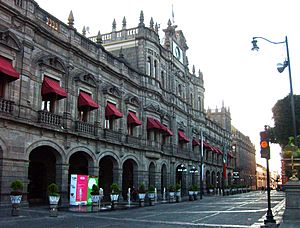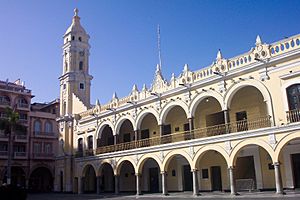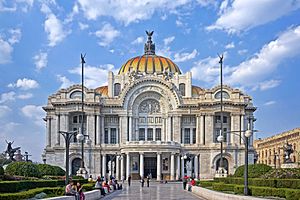Municipalities of Mexico facts for kids
In Mexico, a municipality (called municipio in Spanish) is like a local government area. It's the second main way the country is divided, right after the states. Think of it as a county in some other countries. It's important not to mix up a municipality with a city or town. A city is a place where many people live, but a municipality is a larger area that can include several towns or even a big city.
As of early 2024, Mexico has 2,476 municipalities. This number does not include the 16 special areas in Mexico City, which are called boroughs. Over the past few years, some new municipalities have been created in states like Campeche, Chiapas, Morelos, Quintana Roo, and Baja California.
The rules for how municipalities work are written in Mexico's main law book, the 1917 Constitution. Each state also has its own laws that add more details. Municipalities are different from "localities," which are just places where people live, like neighborhoods (called colonias). Some municipalities can be very large, almost the size of a whole state!
| State | Municipalities |
|---|---|
| 11 | |
| 7 | |
| 5 | |
| 13 | |
| 124 | |
| 67 | |
| 38 | |
| 10 | |
| 39 | |
| 46 | |
| 81 | |
| 84 | |
| 125 | |
| 125 | |
| 113 | |
| 36 | |
| 20 | |
| 51 | |
| 570 | |
| 217 | |
| 18 | |
| 11 | |
| 58 | |
| 18 | |
| 72 | |
| 17 | |
| 43 | |
| 60 | |
| 212 | |
| 106 | |
| 58 |
Contents
How Municipalities Work
Every state in Mexico is divided into municipalities. Each municipality has its own government. Citizens vote for a "municipal president" (presidente municipal). This president leads a group called the municipal council (ayuntamiento). This council is in charge of providing services to the people who live there. This idea, called municipio libre ("free municipality"), started after the Mexican Revolution. It means local areas have more control over their own affairs.
The municipal president is chosen by a simple majority vote. They cannot be elected again for the very next term. The municipal council also includes a chairman (cabildo), a síndico (who handles legal matters), and several regidores (like trustees).
If a municipality is very big and has many towns or cities, one main city is chosen as the cabecera municipal. This is the "head city" where the main government office is. The other towns might have smaller local offices called presidencia auxiliar or junta auxiliar. These smaller offices help with local issues but get their money from the main municipality.
Municipalities in Mexico are a bit like counties in the United States. The auxiliary presidencies are similar to townships. However, these auxiliary presidencies are not considered a separate level of government.
The size of municipalities can be very different. States in the northwest and southeast of Mexico often have fewer, very large municipalities. For example, Baja California has only seven municipalities, but they cover huge areas. This means one municipality can include many separate cities or towns. On the other hand, central and southern states like Oaxaca have many small municipalities (Oaxaca has 570!). In these areas, a big city might actually spread across several different municipalities.
What Municipalities Do
Municipalities are responsible for many important public services. These include providing water and sewer systems, street lighting, and keeping public safety. They also manage traffic, oversee slaughterhouses, and keep public parks, gardens, and cemeteries clean. They can also help the state and federal governments with schools, emergency services like fire and medical help, protecting the environment, and taking care of historical places. Since 1983, municipalities can collect taxes on property and charge fees for services. However, they still get a lot of their money from the state and federal governments.
Some municipalities have even smaller divisions called boroughs or delegaciones. For example, all municipalities in Baja California are divided into boroughs. The Mexicali municipality has 14 boroughs, plus the main city of Mexicali. The leaders of these boroughs are not elected by the people. Instead, they are chosen by the municipal president.
Mexico City is a special case. It's not divided into municipalities like the rest of the country. After some changes in 2016, Mexico City became its own special entity, like a state. It is divided into 16 boroughs, which are used for collecting information and comparing with other areas.
A Brief History of Municipalities
The idea of municipalities in Mexico goes way back to when the Spanish first arrived. They were the basic way to organize towns and cities in New Spain. Important settlements were given the right to form their own local government, called an ayuntamiento or municipality. At first, these local governments had a lot of power. But over time, their power was reduced.
After Mexico became independent, the 1824 Constitution didn't say much about municipalities. So, each state made its own rules for how a town could become a municipality, usually based on how many people lived there.
The 1917 Constitution made a big change. It got rid of the "political authority" that was between the states and the local areas. It made all existing municipalities into "free municipalities" (municipios libres). This gave them more freedom to manage their own local issues. Later, in 1983, the law was changed again to give municipalities even more power to collect money through taxes and fees, and to create their own budgets.
The very first city council in Mexico was set up by Hernán Cortés in 1519 in Veracruz. This was also the first one on the American mainland! Some of the newest municipalities in Mexico include San Quintín and San Felipe in Baja California, Seybaplaya and Dzitbalché in Campeche, and several in Guerrero like Las Vigas and San Nicolás.
Municipalities by Size and Location
Here are some interesting facts about municipalities in Mexico, based on information from 2020.
Municipalities by Population
This table shows the municipalities with the most and fewest people.
| Ranking | Municipality | State | Population |
|---|---|---|---|
| 1 | Mexico City | Mexico City | 9,209,944 |
| 2 | Tijuana | Baja California | 1,922,523 |
| 3 | León | Guanajuato | 1,721,215 |
| 4 | Puebla | Puebla | 1,692,181 |
| 5 | Ecatepec | Mexico | 1,645,352 |
| 6 | Juárez | Chihuahua | 1,512,450 |
| 7 | Zapopan | Jalisco | 1,476,491 |
| 8 | Guadalajara | Jalisco | 1,385,629 |
| 9 | Monterrey | Nuevo León | 1,142,994 |
| 10 | Nezahualcóyotl | Mexico | 1,077,208 |
| 2,450 | San Mateo Tlapiltepec | Oaxaca | 229 |
| 2,451 | Santiago Nejapilla | Oaxaca | 174 |
| 2,452 | Santiago Tepetlapa | Oaxaca | 130 |
| 2,453 | Santo Domingo Tlatayapam | Oaxaca | 113 |
| 2,454 | Santa Magdalena Jicotlán | Oaxaca | 81 |
Municipalities by Area
This table shows the municipalities with the largest and smallest land areas.
| Ranking | Municipality | State | Land Area | |
|---|---|---|---|---|
| km2 | sq mi | |||
| 1 | Mulegé | Baja California Sur | 32,953.3 | 12,723.3 |
| 2 | San Quintín | Baja California | 32,009.9 | 12,359.1 |
| 3 | Ocampo | Coahuila | 26,024.4 | 10,048.1 |
| 4 | Ensenada | Baja California | 19,526.8 | 7,539.3 |
| 5 | Comondú | Baja California Sur | 18,318.6 | 7,072.9 |
| 6 | Ahumada | Chihuahua | 16,910.0 | 6,529.0 |
| 7 | Hermosillo | Sonora | 15,724.3 | 6,071.2 |
| 8 | La Paz | Baja California Sur | 15,413.7 | 5,951.3 |
| 9 | Mexicali | Baja California | 14,528.3 | 5,609.4 |
| 10 | Calakmul | Campeche | 13,987.5 | 5,400.6 |
| 2,450 | Ánimas Trujano | Oaxaca | 3.0 | 1.2 |
| 2,451 | San Pedro Cajonos | Oaxaca | 2.8 | 1.1 |
| 2,452 | Santa Inés Yatzeche | Oaxaca | 2.4 | 0.9 |
| 2,453 | Santa Cruz Amilpas | Oaxaca | 2.3 | 0.9 |
| 2,454 | Natividad | Oaxaca | 2.2 | 0.8 |
Municipalities by Location
- Northernmost: Mexicali, Baja California (32°38′N 114°45′W / 32.633°N 114.750°W)
- Southernmost: Suchiate, Chiapas (14°32′N 92°13′W / 14.533°N 92.217°W)
- Westernmost: Ensenada, Baja California (29°4′N 118°26′W / 29.067°N 118.433°W)
- Easternmost: Isla Mujeres, Quintana Roo (21°11′N 86°42′W / 21.183°N 86.700°W)
- Geographical center: Villa de Cos, Zacatecas (23°55′N 102°9′W / 23.917°N 102.150°W)
- Highest: Tlachichuca, Puebla and Calcahualco, Veracruz (5,636 meters, on the Citlaltépetl volcano).
- Lowest: Mexicali, Baja California (-12 meters, at Laguna Salada).
See also
 In Spanish: Municipios en México para niños
In Spanish: Municipios en México para niños






